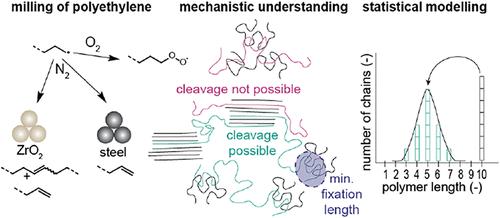球磨过程中聚乙烯链解理的建模与机理研究
IF 5.2
1区 化学
Q1 POLYMER SCIENCE
引用次数: 0
摘要
聚乙烯(PE)和聚丙烯的机械化学转化被证明可以产生单体,因此对化学聚合物回收很感兴趣。由于这些聚合物占全球聚合物产量的50%以上,因此研究它们在球磨过程中的转化尤为重要。然而,由于难以生产出链长和分散性可控的聚烯烃,人们对结晶度、聚合度、缠结和温度对转化的影响缺乏基本认识。本文采用可控链生长聚合法合成聚乙烯,并研究了低温、室温、有空气和无空气、钢球和氧化锆球在球磨过程中的降解情况。所得分子量分布采用统计链裂解模型拟合,表明链裂解概率在链中部呈统计高斯分布。这可能是因为如果链在两个点上固定在纠缠或晶体中,它们就不能滑出,并且力可以作用于它们导致解理。如果解理位置在链的中心,则链很可能固定在可能的解理位置的两侧。当存在连接晶体区域的纠缠结构域时,也会促进链的解理。在没有缠结的情况下,通过铣削得到了一个胶束生长的单晶超高分子量PE,其摩尔质量比经过退火产生缠结的相同样品下降得少得多。然而,与以往的研究和普遍的预期相反,聚合物的初始摩尔质量、结晶度和样品的脆性对链解理没有可测量的影响。虽然与RT相比,在低温条件下摩尔质量的下降速度更快,但核磁共振(NMR)结果表明,这是由于自由基重组受到抑制,而不是由于材料在玻璃化转变温度(~ - 120°C)以下的脆性较高。同样,与氮气气氛相比,在空气中永久性断裂的数量增加了2.6倍,特别是与钢磨球结合使用时。研磨样品的核磁共振谱表明,机械化学形成的链与空气的反应抑制了复合。本文章由计算机程序翻译,如有差异,请以英文原文为准。

Modeling and Mechanistic Study of Polyethylene Chain Cleavage during Ball Milling
Mechanochemical conversion of polyethylene (PE) and polypropylene was shown to produce monomers and is thus interesting for chemical polymer recycling. As these polymers make up more than 50% of the worldwide polymer production, studying their conversion during ball milling is especially relevant. However, fundamental knowledge on the effect of crystallinity, degree of polymerization, entanglement and temperature on the conversion is lacking due to the difficulty in producing polyolefins with controlled chain length and dispersity. Here we synthesize PE by a controlled chain growth polymerization and study its degradation during ball milling at cryogenic conditions, at room temperature (RT), with and without air, and using either steel or zirconia grinding spheres. Resulting molecular weight distributions are fitted using a statistical chain cleavage model suggesting a statistical Gaussian distribution of chain cleavage probability around the middle of the chain. This is likely because if the chains are fixed in an entanglement or crystal at two points, they cannot slip out and force can act on them leading to cleavage. That the chain is fixed at both sides of a possible cleavage location is most likely if the cleavage location is in the center of the chain. Chain cleavage is also promoted when entangled domains exist that link crystalline regions. A micelle grown single crystal ultrahigh molecular weight PE without entanglements was milled and its molar mass decreased much less compared to the same sample that was annealed to create entanglements. However, in contrast to previous studies and common expectations, the initial molar mass of the polymer, the degree of crystallinity and the brittleness of the sample did not have a measurable influence on chain cleavage. While the decrease in molar mass was faster at cryogenic conditions compared to RT, nuclear magnetic resonance (NMR) results suggest that this is due to a suppression of radical recombination rather than the higher brittleness of the material below its glass transition temperature (∼−120 °C). Similarly, the number of permanent scissions increased by up to 2.6 times under air compared to nitrogen atmosphere, especially in combination with steel milling spheres. NMR spectra of the milled samples suggest that the reaction of mechanochemically formed chains with air suppresses recombination.
求助全文
通过发布文献求助,成功后即可免费获取论文全文。
去求助
来源期刊

Macromolecules
工程技术-高分子科学
CiteScore
9.30
自引率
16.40%
发文量
942
审稿时长
2 months
期刊介绍:
Macromolecules publishes original, fundamental, and impactful research on all aspects of polymer science. Topics of interest include synthesis (e.g., controlled polymerizations, polymerization catalysis, post polymerization modification, new monomer structures and polymer architectures, and polymerization mechanisms/kinetics analysis); phase behavior, thermodynamics, dynamic, and ordering/disordering phenomena (e.g., self-assembly, gelation, crystallization, solution/melt/solid-state characteristics); structure and properties (e.g., mechanical and rheological properties, surface/interfacial characteristics, electronic and transport properties); new state of the art characterization (e.g., spectroscopy, scattering, microscopy, rheology), simulation (e.g., Monte Carlo, molecular dynamics, multi-scale/coarse-grained modeling), and theoretical methods. Renewable/sustainable polymers, polymer networks, responsive polymers, electro-, magneto- and opto-active macromolecules, inorganic polymers, charge-transporting polymers (ion-containing, semiconducting, and conducting), nanostructured polymers, and polymer composites are also of interest. Typical papers published in Macromolecules showcase important and innovative concepts, experimental methods/observations, and theoretical/computational approaches that demonstrate a fundamental advance in the understanding of polymers.
 求助内容:
求助内容: 应助结果提醒方式:
应助结果提醒方式:


